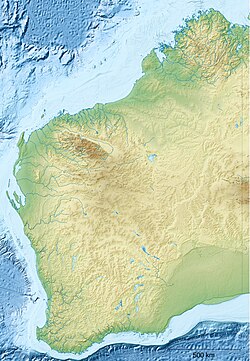Country
Tindale's range estimates
The only information on the Mandjindja's country are estimates given by Norman Tindale. Tindale's estimates (particularly for the peoples of the Western desert) are not considered to be accurate.
Tindale estimated that the Mandjindja's territory extended over roughly 21,000 square miles (54,000 km2), in the sandhill terrain south of the Warburton Range, from a place called Papakula ("Babbagoola Rockhole" on maps). Their western extension went as far as the Gillen and Throssell lakes. Their southern boundaries lay around Amy Rocks and the Saunders Range. Their eastern confines lay around a place named Lenga:na, identified as possibly east of the Sydney Yeo Chasm.
The Koara people, more recently spelt Kuwarra, are an Aboriginal Australian people living in the Kuwarra Western Desert region of Western Australia. In its fullest extent it would constitute portions of land in the Pilbara, Mid West, and Goldfields-Esperance regions of Western Australia.

The Kabi Kabi people, also spelt Gubbi Gubbi, Gabi Gabi, and other variants, are an Aboriginal Australian people native to South Eastern Queensland. During the Australian frontier wars of the 19th century, there were several mass killings of Kabi Kabi people by settlers. They are now classified as one of several Murri language groups in Queensland. A 2024 determination granted non-exclusive native title rights over an 365,345-hectare (902,790-acre) area of land and waters on the Sunshine Coast.

The Great Central Road is a mostly unsealed Australian outback highway that runs 1,126 km (700 mi) from Laverton, Western Australia to Yulara, Northern Territory. It passes through a number of small communities on the way. It forms part of the Outback Way which goes all the way to Winton, Queensland.
The Martu (Mardu) are a grouping of several Aboriginal Australian peoples in the Western Desert cultural bloc.
Kado Muir is an Australian Aboriginal artist, anthropologist, archaeologist, and Indigenous rights activist in Western Australia.

The Nyikina people are an Aboriginal Australian people of the Kimberley region of Western Australia.
The Karajarri are an Aboriginal Australian people, who live south-west of the Kimberleys in the northern Pilbara region, predominantly between the coastal area and the Great Sandy Desert. They now mostly reside at Bidyadanga, south of Broome. To their north live the Yawuru people, to the east the Mangala, to the northeast the Nyigina, and to their south the Nyangumarta. Further down the coast are the Kariera.
The Nyamal are an Indigenous Australian people of the Pilbara area of north-western Western Australia.
Keiadjara, also rendered Kiyajarra, were an Aboriginal Australian people of the Pilbara region of Western Australia.
The Ngolibardu, otherwise written Ngulipartu, were an Aboriginal Australian people of Western Australia.
The Ngarla are an Aboriginal Australian people of the Pilbara region of Western Australia.
The Mandjildjara, also written Manyjilyjarra, are an Aboriginal Australian people of Western Australia.
The Walmadjari (Walmajarri) people, also known as Tjiwaling and Wanaseka, are an Aboriginal Australian people of the Kimberley region of Western Australia.
The Kukatja people, also written Gugadja, are an Aboriginal Australian people of the Kimberley region of Western Australia.
The Kurajarra were an Aboriginal Australian people of the Pilbara region of Western Australia.
The Ildawongga are an Aboriginal Australian people of the Pilbara region of Western Australia.
The Ngaatjatjarra are an Indigenous Australian people of Western Australia, with communities located in the north eastern part of the Goldfields-Esperance region.
The Nakako are an Aboriginal Australian people of Western and Southern Australia.
The Ngalia, or Ngalea, are an Aboriginal Australian people of the Western Desert cultural bloc resident in land extending from Western Australia to the west of South Australia. They are not to be confused with the Ngalia of the Northern Territory.
The Kokatha, also known as the Kokatha Mula, are an Aboriginal Australian people of the state of South Australia. They speak the Kokatha language, close to or a dialect of the Western Desert language.
This page is based on this
Wikipedia article Text is available under the
CC BY-SA 4.0 license; additional terms may apply.
Images, videos and audio are available under their respective licenses.



